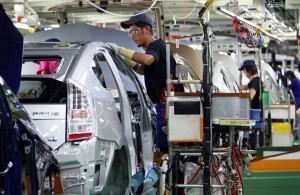The devastating disaster that struck Japan last month has a calamitous impact on the world’s largest automaker, Toyota Motor Co. today reporting its global output fell by nearly a third in March — and with the company unlikely to resume normal production levels until the very end of 2011, Toyota seems all but certain to lose its position as industry sales leader.
But Toyota is by no means unique among Japanese makers. The Asian nation’s powerful auto industry has been humbled by the combination of a 9.0-magnitude earthquake, tsunami and nuclear power crisis that continues to wreak havoc on Japan’s manufacturing capabilities.
Toyota has been especially hard hit because it depends more on Japanese assembly lines than other major Japanese makers, like Nissan and Honda, who have steadily shifted more and more of their production abroad. But even those makers are struggling because of their continuing dependence on Japanese-made parts shipped to so-called “transplant” assembly lines in North America, Europe and other parts of the world.
Toyota’s Japanese-based plants were all but shut down in the wake of the March 11 disaster, vehicle output for the month plunging to just 129,491, a 63% decline. Of that number, 107,751 were exported, a 33% drop from year-earlier levels.
But even Toyota’s transplants felt the pinch, partly due to the company’s strict Just-in-Time production system, which limits the amount of inventory maintained at assembly plants – making them particularly vulnerable to the interruptions in parts deliveries.
On a worldwide basis, Toyota production slipped 30% in March, to just 542,465. And the automaker warned, last week, that it expects to lose about 400,000 additional units of production in April, due to ongoing parts shortages – including 100,000 units trimmed from transplant schedules.
Toyota has announced it will run its North American factories at barely one-third of their straight-time capacity through at least early June, those plants scheduled for shutdown Mondays and Fridays, and only running half-time Tuesday through Thursday.
On Friday, Toyota said it does not expect to resume normal production schedules worldwide until November or even December of this year.
That means Toyota is unlikely to reach the 8.42 million sales it rang up in 2010, never mind meet the goal of boosting volumes, as outlined by CEO Akio Toyoda in the “Global Vision” strategy he outlined just two days before the disastrous earthquake and tsunami flattened much of the northeast coast of Japan.
Toyota and its Japanese-based competitors have been desperately struggling to reestablish their original parts networks – or to line up alternatives. Part of the problem is that they are heavily dependent on Japanese sources and many of those suppliers were devastated by the events of March 11. Few more so than Renesas Electronics, which produces critical chips for about 30% of the micro-controllers used by the global auto industry. A key Renesas plant won’t resume operations until June 15.
But Merck, the German chemical giant, has also created problems for automakers that include Detroit’s Ford and Chrysler because its pigment plant, in the quake-damaged region, is the only source for a variety of popular colors, including Ford’s Tuxedo Black.
Complicating matters, Japanese home market assembly plants continue to face rolling blackouts, the result of the ongoing crisis at the Fukushima Daiichi nuclear plant.
All told, Honda’s production dipped 19% worldwide in March, and 63% in the home market, to 282,254 vehicles. Nissan, Japan’s second-largest automaker, actually increased production, thanks to its large network of transplants, though home-market output slipped 52%.
Both makers acknowledge they will face some parts shortages – and consequent production cuts — for months to come, as will most of the smaller Japanese automaker.
In all, about 150 key auto parts produced in Japan are currently in short supply. Most are rubber and plastic components, but while it may be possible to shift their production elsewhere industry observers warn that the problems facing Renesas and other high-tech components could be more difficult to overcome.
Industry analysts, meanwhile, are forecasting the crisis will have a significant impact on the Japanese auto industry’s finances. The crisis came too close to the March 31st end of the Japanese fiscal year to do much damage, so far, but Deutsche Bank, for one, now predicts that all Japanese automakers will be in the red during at least the first half of the new fiscal year.

